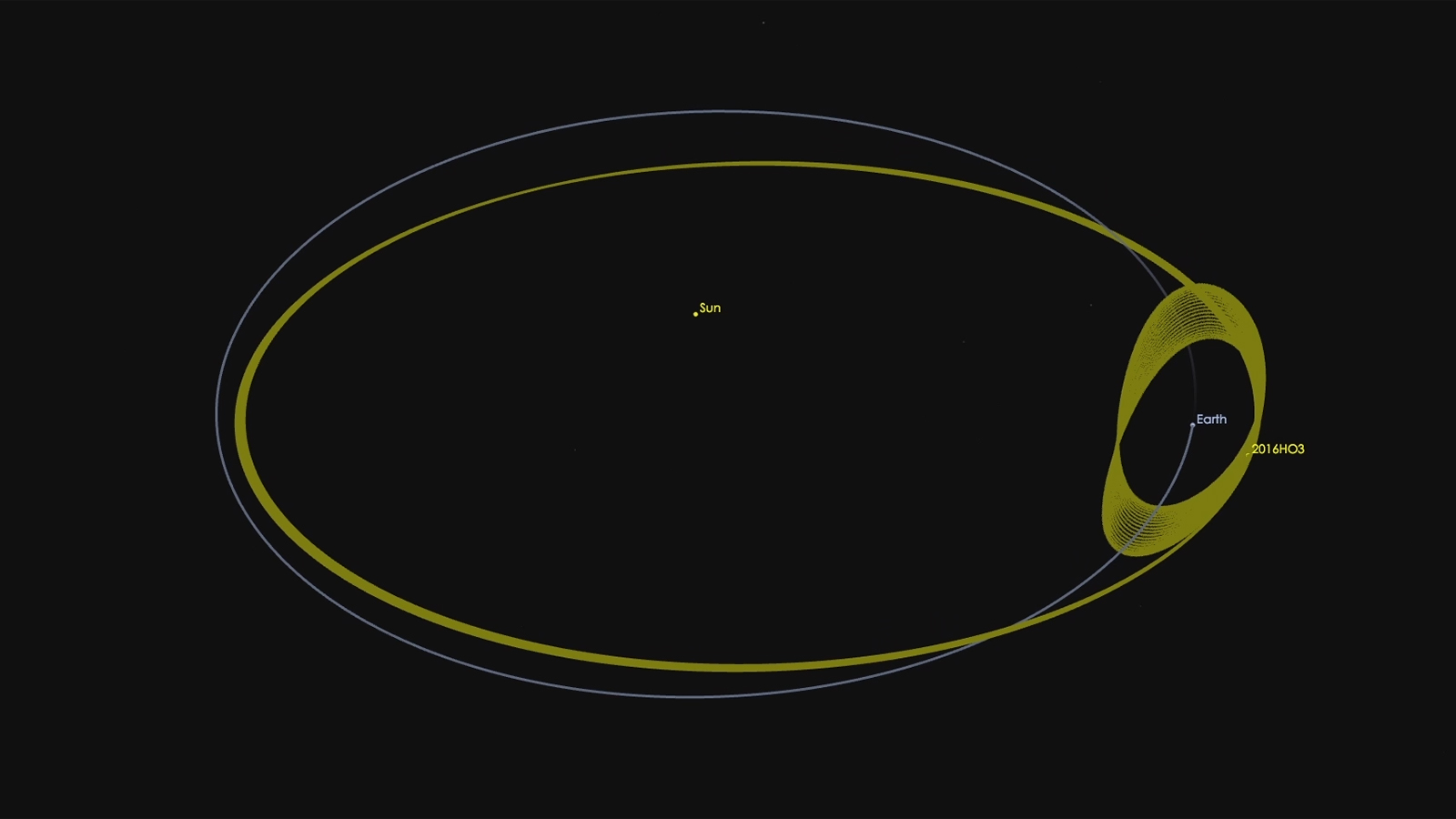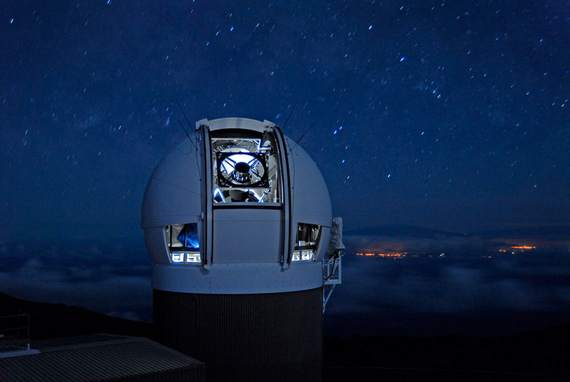Quasi-satellite detected on Earth orbit
June 15 on the official website of the laboratory NASA published a publication telling about the asteroid, which for several centuries will become the second satellite of the Earth. We will describe below what is the satellite candidate of our planet discovered by astronomers.

We are sure that the Moon is the only natural satellite of the Earth, at the same time, the gravitational field of our planet is quite capable of capturing asteroids of relatively small size for some time, passing by, turning them into so-called. "Quasi-companions".
Asteroid 2016 HO3, in question, was first recorded on April 27, 2016 by the Pan-STARRS 1 asteroid telescope (Panoramic Survey Telescope and Rapid Response System). This system of panoramic and rapid response telescopes located on the Halikala Volcano (Maui Island, Hawaii) was organized thanks to the financial support of the NASA Planetary Protection Coordination Bureau and allows you to detect up to 99% of asteroids ranging in size from 300 meters and more to Earth crossing the orbit.
')

After analyzing an unusual orbit of a found asteroid, astronomers of the Jet Propulsion Laboratory in Pasadena (California, USA) found that it rotates not only around the Sun, but also around the Earth. The asteroid is far enough away from our planet to be considered its true satellite, but at the same time, it is by far the most visible and stable example of the Earth’s “quasi-satellite” - noted in NASA.
10 years ago, astronomers have already observed the asteroid 2003 YN107 with a similar orbit pattern, but since then it has already managed to leave the near-Earth region of space. The new object of attention is fixed by gravitational forces much more reliably. Calculations by NASA experts show that 2016 HO3 will play the role of a stable quasi-satellite of the Earth for almost a century, and many hundreds of years will remain in the sphere of influence of the planet in one form or another.
In its annual motion together with the Earth around the Sun, the asteroid 2016 HO3 is about half the time closer to the Sun than the Earth, being ahead of our planet, and about half the time further and behind. Its orbit is slightly tilted to the plane of the Earth's orbit, so it floats above it once a year and then dives under it. And this kind of frog jumping 2016 HO3 will be repeated for hundreds of years.
The asteroid's orbit plane also performs a slow back-forward turn with a period of several decades. Its loops drift slightly in front or behind, not moving away for a long distance, but also not approaching close enough. The maximum calculated distance is 100 times the distance from the Earth to the Moon (about 40 million km). In the closest point to Earth orbit, the asteroid is located about 38 times farther from the moon (about 15 million km). According to the figurative expression of one of the astronomers who study an unusual guest, this small asteroid seems to be dancing with the Earth.
The size of the detected asteroid is not yet precisely determined, but, in all likelihood, this value lies in the range from 40 to 100 meters.
According to the materials of the Jet Propulsion Laboratory in Pasadena
That's all, with you there was a simple service for choosing sophisticated Dronk.Ru equipment. Do not forget to subscribe to our blog , there will be many more interesting ...


We are sure that the Moon is the only natural satellite of the Earth, at the same time, the gravitational field of our planet is quite capable of capturing asteroids of relatively small size for some time, passing by, turning them into so-called. "Quasi-companions".
Asteroid 2016 HO3, in question, was first recorded on April 27, 2016 by the Pan-STARRS 1 asteroid telescope (Panoramic Survey Telescope and Rapid Response System). This system of panoramic and rapid response telescopes located on the Halikala Volcano (Maui Island, Hawaii) was organized thanks to the financial support of the NASA Planetary Protection Coordination Bureau and allows you to detect up to 99% of asteroids ranging in size from 300 meters and more to Earth crossing the orbit.
')

After analyzing an unusual orbit of a found asteroid, astronomers of the Jet Propulsion Laboratory in Pasadena (California, USA) found that it rotates not only around the Sun, but also around the Earth. The asteroid is far enough away from our planet to be considered its true satellite, but at the same time, it is by far the most visible and stable example of the Earth’s “quasi-satellite” - noted in NASA.
10 years ago, astronomers have already observed the asteroid 2003 YN107 with a similar orbit pattern, but since then it has already managed to leave the near-Earth region of space. The new object of attention is fixed by gravitational forces much more reliably. Calculations by NASA experts show that 2016 HO3 will play the role of a stable quasi-satellite of the Earth for almost a century, and many hundreds of years will remain in the sphere of influence of the planet in one form or another.
In its annual motion together with the Earth around the Sun, the asteroid 2016 HO3 is about half the time closer to the Sun than the Earth, being ahead of our planet, and about half the time further and behind. Its orbit is slightly tilted to the plane of the Earth's orbit, so it floats above it once a year and then dives under it. And this kind of frog jumping 2016 HO3 will be repeated for hundreds of years.
The asteroid's orbit plane also performs a slow back-forward turn with a period of several decades. Its loops drift slightly in front or behind, not moving away for a long distance, but also not approaching close enough. The maximum calculated distance is 100 times the distance from the Earth to the Moon (about 40 million km). In the closest point to Earth orbit, the asteroid is located about 38 times farther from the moon (about 15 million km). According to the figurative expression of one of the astronomers who study an unusual guest, this small asteroid seems to be dancing with the Earth.
The size of the detected asteroid is not yet precisely determined, but, in all likelihood, this value lies in the range from 40 to 100 meters.
According to the materials of the Jet Propulsion Laboratory in Pasadena
That's all, with you there was a simple service for choosing sophisticated Dronk.Ru equipment. Do not forget to subscribe to our blog , there will be many more interesting ...

 |  |  |
| Why do online stores give money for purchases? | Save up to 8% on every purchase on AliExpres and other online stores in China | Return your money - choose a cashback service for Aliexpress |
Source: https://habr.com/ru/post/395221/
All Articles